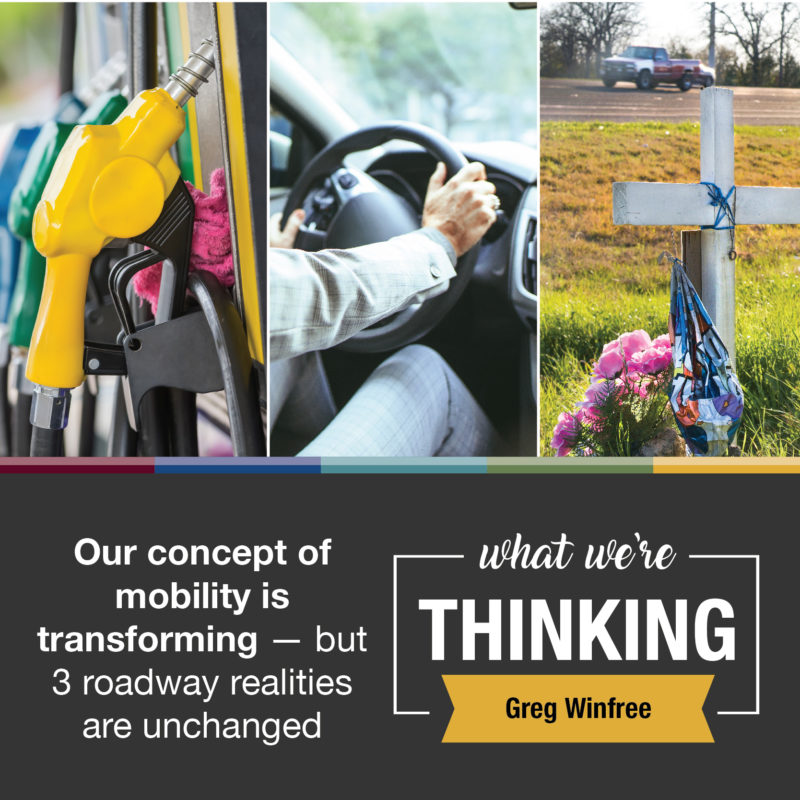This is not your grandfather’s mobility landscape. Not even your father’s. Not even close.
Thanks to the sharing economy, we have more here-to-there options today than we would have dared to imagine a decade ago. And transportation today depends almost as much on smartphones as it does on steering wheels.
How we define, provide and experience mobility is transforming at a screamer pace. At the same time, though, three things about how we get around don’t seem to be changing at all, and their implications could hamper our otherwise rapid progress.
We still prefer a solo commute. Roadway gridlock is on a steady growth trend, according to the 2019 Urban Mobility Report released in August by the Texas A&M Transportation Institute. Our research spotlights the direct link between job growth and traffic, so a strong economy only adds to the gridlock problem.
Travel delay cost the average commuter 54 hours and $1,010 last year. The lure of a less painful experience in carpool lanes might push a few of us to share rides, or maybe opt for public transportation. But still, roughly three-quarters of American commuters drive to work alone in their cars. Ride-hailing options don’t do much to change that picture, as the share of ride-splitting customers constitutes roughly 20 percent of Uber and Lyft trips. Those companies may have revolutionized how we get around, but they’ve not done much to dissuade us from our solitary tendencies.
We still pay for infrastructure the same way we did in 1932. The Federal tax on gasoline started that year, at one cent per gallon. For its entire history, it’s been a unit tax, not a sales tax, so the amount of the tax doesn’t change, no matter what the price of gas may be. The last time Congress raised the tax was in 1993, when it was set at 18.4 cents per gallon, where it’s been ever since. The cost of building and repairing roads and bridges, however, has steadily increased along with inflation, so the tax pays for barely half what it did a quarter century ago. As our needs grow along with population every year, our funding shrinks.
The most obvious remedy would be to raise the tax. But there’s little political interest in that idea. Alternatively, we could charge drivers a mileage fee in lieu of the tax; a few states have been exploring that option. I’m not making an argument for either approach; my point is that the status quo is unsustainable. No matter how quickly mobility may change, our need for reliable roads and bridges will remain for years to come. We should be talking more about how we’ll pay for them.
We still accept roadway fatalities as a price we pay for mobility. About 40,000 Americans die every year on our roadways — an average of 110 every day. If 100 people died every day because of plane crashes, we would ground flights while experts found the cause and leaders took aggressive action to stop the carnage. If 100 deaths every day were tied to a single food product, that commodity would be yanked from store shelves across the country in a matter of hours. But where’s the urgency to reduce roadway deaths? Unless the person who dies is someone we know, we have become anesthetized to this public health crisis.
That’s not to say, however, that we haven’t progressed in terms of safety. Roadway deaths would no doubt be more common were it not for infrastructure improvements like crash cushions and energy-absorbing guardrails. Seat belts and air bags have made crashes more survivable, while features like automatic braking, adaptive cruise control, and lane control assistance have made them less likely.
And technology may save us yet again if the promise of self-driving cars can be fully realized. Automated travel can prevent the vast majority of crashes caused by human error. That would be truly transformative, but it’s not going to happen until self-driving cars become ubiquitous. We’re at least a couple of decades out from that breakthrough time.
Our mobility future is rich with new potential, at the same time that it’s imperiled by old complications. But here’s the good news: Americans can do hard stuff. We have created ways to move ever more swiftly and efficiently across continents, oceans and skies. If we can do those things, certainly we can make our system more efficient, more financially sustainable and safer, by leveraging new solutions.
Maybe reducing traffic congestion calls for reducing roadway demand as much as adding roadway supply. Maybe paying for roads and bridges should reflect how we travel as much as what fuels what we drive. And maybe there are better ways to improve driver behavior that don’t require us to change a lot of laws. Maybe; we won’t know until we try.
There’s no reason why the next 10 years in transportation can’t be exciting and fruitful. It’ll mean doing some hard stuff, but just remember, we’re good at that.
Gregory Winfree is the agency director of the Texas A&M Transportation Institute and a former U.S. assistant secretary of transportation.
This article was originally published in The Hill, November 9, 2019.
